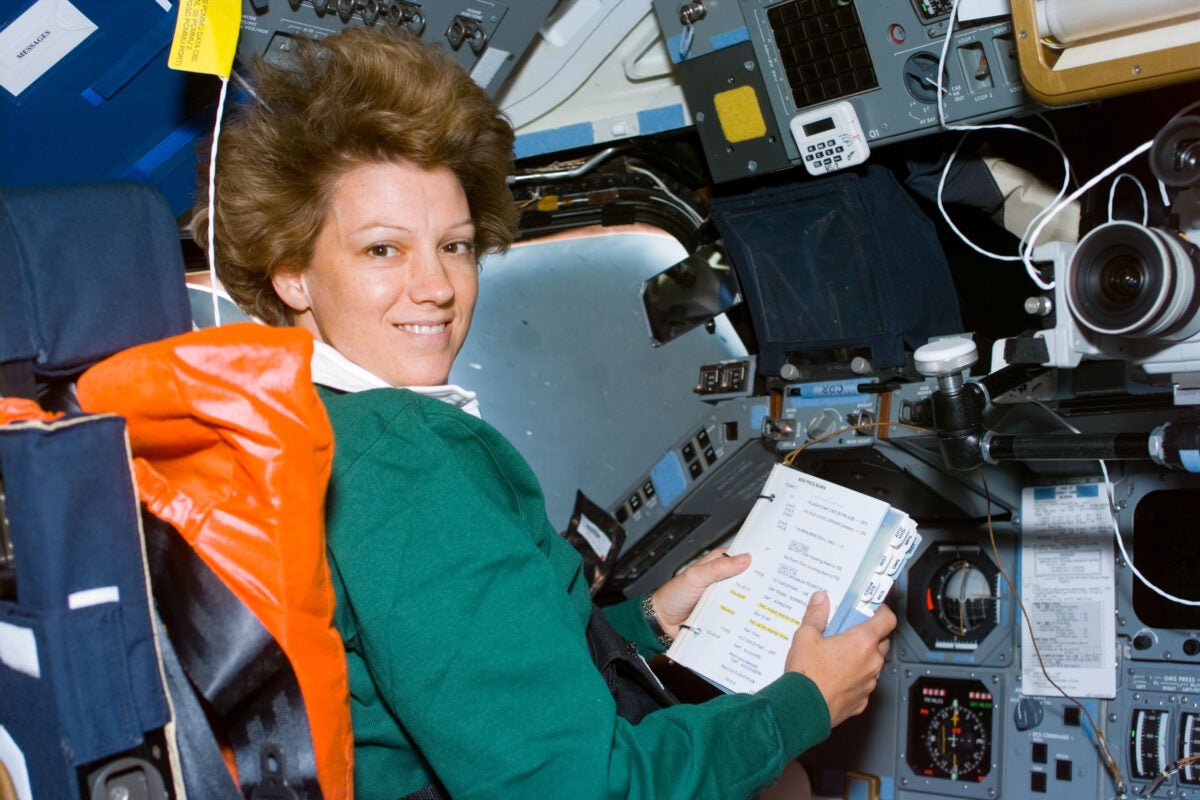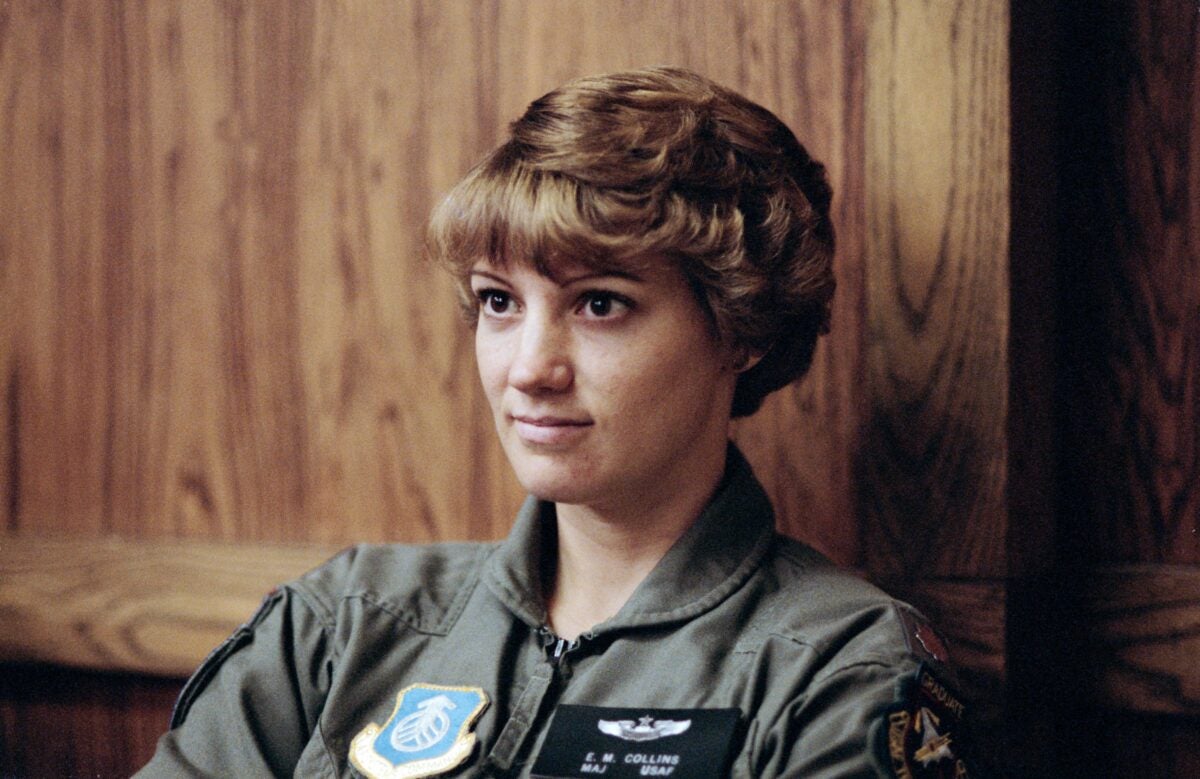
Mission commander Eileen Collins reviews a checklist on the space shuttle Columbia in 1999. Credit: NASA.
Twenty-five years ago, Eileen Collins became the first woman to command a space flight. A test pilot, mathematician, and pioneer, this soft-spoken Air Force colonel commanded the space shuttle Columbia when it roared into the post-midnight darkness of Florida on July 23, 1999. Its STS-93 crew deployed $1.5 billion from NASA. Chandra X-ray Observatory —at 25 tons, it was the heaviest payload ever carried by the shuttle—to reveal the high-energy universe.
Of Irish descent from County Cork, Collins grew up in Elmira, New York, once the site of a notorious prison for Confederate soldiers during the Civil War. “Our town produced its fair share of famous citizens,” he acknowledged in his memoirs. Through the glass ceiling to the starsAmong them were filmmaker Hal Roach, fashion designer Tommy Hilfiger and writer Mark Twain in his later years.
Elmira was also home to the National Museum of Gliding, atop Harris Hill, and a young Collins watched with glee as gliders flew overhead. “My father didn’t have the money to give me flying lessons when I was a kid,” she told a NASA interviewer, “so I had to wait until I was 16, get a job and save up my money.”
A pilot from the beginning
His aviation career began as a Cessna pilot, then he earned a glider license and eventually joined the military. He studied mathematics and went on to fly Northrop's T-38 supersonic aircraft, Lockheed's C-141 strategic transport aircraft, and instructed young pilots on Cessna's T-41 trainer aircraft.

By 1990, Collins had completed two master's degrees, attended test pilot school, and landed an assistant professor position at the Air Force Academy. By then, NASA officials had selected her as the first female shuttle pilot. In 1995, aboard STS-63, Collins piloted Discovery within 30 feet (10 meters) of From Russia Mir Spacial stationa feat that earned him the coveted Harmon Aviation Trophy.
In 1997, aboard STS-84, he piloted Atlantis To couple with Mirswapping crew members and delivering 7,300 pounds (3,300 kilograms) of cargo. With two flights under her belt, Collins was now eligible for command. Her lifelong interest in astronomy led her to the Chandra mission and in 1998 she was chosen as commander of STS-93.
First Lady Hillary Clinton's announcement came in the opulent Roosevelt Room of the White House. “To discover new worlds,” NASA Administrator Dan Goldin told a crowd of camera-toting reporters, “we must break down old barriers.”
Women in aviation
Collins's triumph capped a list of female accolades in the 20th century, a century in which women firmly rejected imposed social norms and won the right to vote, work, receive an education and hold public office.
Women had long been captivated by the alluring allure of aviation: from Aida de Acosta, the first to fly a powered aircraft in 1903, to Raymonde de Laroche, the first to earn a pilot's license in 1910, and from Georgia “Tiny” Broadwick, the first female parachutist in 1913, to Amelia Earhart, who soloed across the Atlantic in 1932 but died during an attempted global circumnavigation in 1937.
Later, Jacqueline Cochran broke the sound barrier for women in 1953, Betty Miller soloed across the Pacific in 1963, and Jerrie Mock flew solo around the world for the first time in 1964. “It took a lot of courage to fly as a woman” in those days, Collins reflected admiringly, “when that really wasn’t a woman’s place.”
Columbia launches
In July 1999, after multiple delays, the STS-93 mission was finally ready for liftoff. Two launch attempts that month were canceled: the first because of a sensor malfunction, the second because of the risk of lightning. Late in the afternoon of July 22, Collins and his crew headed to the launch pad, hopeful that the third time would be the charm.
Columbia lifted off at 12:31 a.m. EDT, its three main engines and two solid rocket boosters turning midnight into instant daylight over sleepy Florida. But all was not well.
During the burn, a liquid oxygen pin broke loose, striking the inner surface of one of the main engine nozzles, tearing cooling tubes and causing a hydrogen leak. An electrical short disabled one of the two backup engine controllers. The astronauts reached orbit, deployed Chandra and returned safely to Earth five days later, but the grisly incident grounded the shuttle fleet for six months.
Collins’ success brought to a close a century of flight that saw not just female aviators, but the first women to conquer space. Russian Valentina Tereshkova became the first female cosmonaut in 1963. She was a factory seamstress, and the Soviet Union cynically exploited her humble status to support the narrative that under communism “anyone” could reach space.
The rivalry between the United States and the Soviet Union
But the reality that no other Russian woman followed Tereshkova for two decades undid that narrative, exposing its fiction. Meanwhile, in 1978, NASA chose six female astronauts: including Sally Ride, who became the first American woman in space in 1983, and Kathy Sullivan, the first American woman to walk in space in 1984.
In a cleverly planned propaganda stunt, Soviet cosmonaut Svetlana Savitskaya flew in 1982 and then again in 1984. and performed a spacewalk, surpassing Ride and Sullivan as the first woman to fly two missions and perform an Extravehicular Activity (EVA).
Few Western observers harbored any illusion that Savitskaya’s EVA was anything more than an ideological stunt. And in another case of geopolitical one-upmanship, Savitskaya trained to command an all-female mission in 1986 to coincide with International Women’s Day. But the flight was canceled because of problems with the Russian space station Salyut 7.
By the end of the decade, ten American women had flown — including Anna Fisher, the first mother in space — compared with two Russians. And by the end of the millennium, that number had grown to 36 women from six countries, including the first female astronauts from Canada in 1992, Japan in 1994, France in 1996 and the first national space traveler from the United Kingdom.
As the last millennium drew to a close, women performed spacewalks outside space stations and serviced the Hubble Space Telescope, conducted scientific research and flew space shuttles. In 1991, Helen Sharman made Britain the first nation whose first space traveller was a woman. And in 1996, American Shannon Lucid logged a record 188 days on a single mission.
In the new millennium, the records continued to be broken. In 2001, Susan Helms performed the longest EVA ever conducted by a woman, lasting eight hours and 55 minutes. And in 2008, Peggy Whitson completed her second long-duration stay on the International Space Station with a cumulative total of 376 days—the first woman to spend a cumulative year off-planet.
Whitson was also the first female commander of the ISS, and the first few weeks of her promotion in 2007-2008 happily coincided with the arrival of Discoveryled by Pam Melroy. It was the first time that two spacecraft were simultaneously commanded by women. Whitson's subsequent career included two more missions to the International Space Station and she has now logged 675 days, more than any other female space traveler.
Women have also reached orbit from South Korea in 2008, China in 2012, Italy in 2014, Saudi Arabia in 2023 and Belarus in 2024. American astronauts Christina Koch and Jessica Meir conducted the first all-female spacewalk in 2019. And in 2020, Koch returned home after 328 uninterrupted days — the longest mission yet by a woman. She is now training for Artemis II and will become the first woman to travel to the Moon.
The legacy of Eileen Collins
Female commanders quickly followed in Collins’ footsteps. Pam Melroy (current NASA deputy administrator) and Susan Kilrain both served as shuttle pilots, with Melroy becoming the second woman to command a space flight. Four women, including Italian Samantha Cristoforetti, have commanded the International Space Station. And three women have led flights of the SpaceX Dragon.
Today, women make up 12 percent of space travelers. When you count suborbital flights by Blue Origin and Virgin Galactic, plus orbital missions, they have flown for 15 sovereign countries, including the first female astronaut with prosthetics, a film actress, a mother and daughter from Antigua and Barbuda, and the first national astronauts from Egypt and Pakistan.
They all owe a tribute to Eileen Collins, who a quarter of a century ago was a role model for women around the world that not even the sky should impose limits on their ambitions.








Leave feedback about this